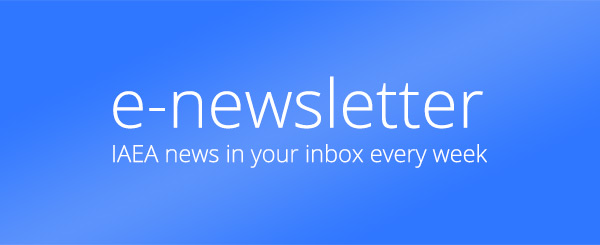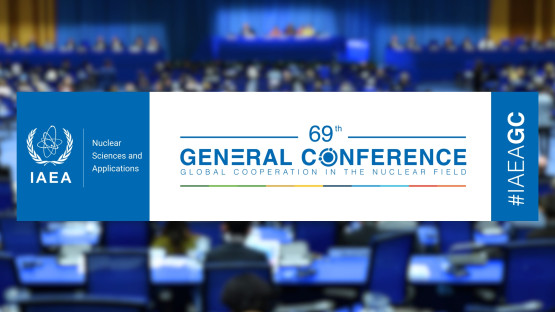Nuclear Sciences and Applications Side Events at the 69th IAEA General Conference
Inauguration of the IAEA’s Transportable Electron Beam System
The IAEA Director General will be joined by member country representatives for the official inauguration of the IAEA’s Transportable E-Beam System. The facility treats liquids, solids and gases, helping to tackle environmental issues such as wastewater, sludge, chemicals and greenhouse gases treatment. It will also help improve industrial processes such as plastic upcycling and vaccine production. The system will be a cornerstone of the IAEA’s assistance to member countries in building capacity and in bridging gaps to address the need for cost-effective and accessible e-beam technology (#ebeams4Development).
The system will enable experts to conduct activities that support NUTEC Plastics, Atoms4Food, ZODIAC, Atoms4Climate, Atoms4Heritage and learn about the possibilities for loaning the system to member countries for dedicated experiments and demonstrations.
This event will be held on Tuesday, 16 September 2025, from 9.00 a.m. to 9.30 a.m. at A Building, -3 level, by the 40-feet intermodal shipping container.
Beyond Boundaries: The Rays of Hope Anchor Centre Network and the Future of Cancer Care
Two years into its establishment, the IAEA Anchor Centre network now unites 12 leading regional institutions advancing cancer care through education and training. This event will showcase virtual reality (VR) innovations in radiation medicine education and patient care, featuring inter alia a presentation on the IAEA’s VR-based training tools. The event will conclude with an Anchor Centre signing ceremony highlighting the continuing growth of the global network.
This event will be held on Tuesday, 16 September 2025, from 11.30 a.m. to 3.00 p.m. in Conference Room CR4, C Building, seventh floor.
Science in Action: Building Skills and Sharing Knowledge at the IAEA Nuclear Applications Laboratories
This side event will highlight the IAEA’s education, hands-on training and technical services efforts through its nuclear applications laboratories. These laboratories provide hands-on training in areas such as health, food and agriculture and environmental monitoring. The session will also present the newly developed training catalogue – a comprehensive resource consolidating 61 specialized courses offered at the Austria-based laboratories. Designed to improve access, coordination, and visibility, the catalogue supports member countries to leverage nuclear science for sustainable development and addresses the growing demand for practical expertise in peaceful nuclear technologies.
This event will be held on Tuesday, 16 September 2025, from 1.00 p.m. to 1.30 p.m. at ESPACE M0E, M Building, ground floor.
The IAEA and the International Year of Glacier Preservation
In recognition of 2025 as the International Year of Glacier Preservation, this event will showcase the diverse of the IAEA in assisting member countries in understanding the impacts of glacier retreat on freshwater sustainability. The event will feature case studies from Central Asia, Europe and South America.
This event will be held on Wednesday, 17 September 2025, from 4.00 p.m. to 5.00 p.m. in Conference Room CR4, C Building, seventh floor.
Advancing Irradiated Vaccines: Innovations, Policies and the Future
This side event will present the Texas A&M/IAEA innovative partnership to develop irradiated vaccines, which maintain structural integrity and elicit better immune response. The IAEA has spearheaded research and development on the application of irradiated vaccines for more than 25 pathogens. Knowledge on the development of irradiated vaccines and sustainable approaches will be shared, and challenges related to animal diseases for which available vaccines are limited or have reduced efficacy will be discussed.
This event will be held on Thursday, 18 September 2025, from 1.00 p.m. to 2.00 p.m. in Conference Room CR3, C Building, third floor.
Tours
Isotope Hydrology Laboratory Tours
Visitors to the IAEA’s Isotope Hydrology Laboratory in the VIC will be shown laboratory facilities that support member countries in the application of nuclear and nuclear-related techniques for the isotopic analysis of water samples. This tour will include the tritium and noble gas facilities for age dating groundwater and the laser lab where stable oxygen and hydrogen isotopes are analysed to provide information about the hydrological cycle.
Tours will be offered on Tuesday, Thursday, and Friday of the General Conference during the lunch break (1.15 p.m. to 2.00 p.m.). Space is limited to 12 people per tour and registration is required. To sign up for a tour, please email us with your name, affiliation, and the day you wish to visit the lab. Confirmed participants should meet at the Information Desk located at the entrance to the M-building 10 minutes before the start of the tour.
Tour of the IAEA’s Nuclear Applications Laboratories in Seibersdorf
Visitors to the IAEA nuclear applications laboratories in Seibersdorf will see how the eight laboratories support member countries in the peaceful application of nuclear and nuclear-related techniques for socioeconomic development and environmental protection in areas such as food and agriculture, medical dosimetry, terrestrial environment and nuclear instrumentation.
The tour will be offered on Thursday, 18 September 2025, from 9 a.m. to 1.00 p.m. Advance registration is required via email by 12 noon on Tuesday, 16 September 2025, to NALabs@iaea.org, stating your first and family name, affiliation, delegation and telephone number. Confirmed participants should meet at the Information Desk at the entrance to the M building at 8.50 a.m. on Thursday, 18 September. Buses will take visitors from the VIC to Seibersdorf and return four hours later. Due to space constraints, a maximum of 60 visitors can be accommodated.
Visit the new IAEA Transportable Electron Beam System
The IAEA’s new Transportable Electron Beam (e-beam) Accelerator System is a versatile facility that allows the treatment of liquids, solids and gases. It will be a cornerstone of the IAEA’s assistance to member countries in building capacity and in bridging gaps to address the need for cost-effective and accessible e-beam technology.
The 40-feet intermodal shipping container will be on display at A Building, -3 level. Experts will brief delegates about its capabilities, operation, safety aspects and the possibilities for loaning the system to member countries for dedicated experiments and demonstrations. The system will not be operational while on display at the VIC (i.e. no radiation protection measures are needed).
The facility is available to visit daily, between 8.00-9.00 a.m. and 1.00-3.00 p.m. No registration is required.


